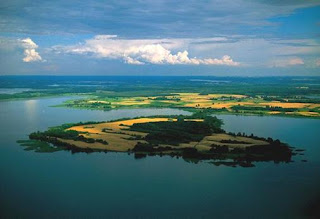 The Masurian Lake District or Masurian Lakeland is a lake district in northeastern Poland containing more than 2,000 lakes. It extends roughly 290 km eastwards from the lower Vistula River to the Poland-Lithuania border and occupies an area of roughly 52,000 square kilometers. The lake district was shaped by the Pleistocene ice age. Many of its hills are parts of moraines and many of its lakes are moraine-dammed lakes. The lakes are well connected by rivers and canals, forming an extensive system of waterways. The 18th-century Masurian Canal links this system to the Baltic Sea.
The Masurian Lake District or Masurian Lakeland is a lake district in northeastern Poland containing more than 2,000 lakes. It extends roughly 290 km eastwards from the lower Vistula River to the Poland-Lithuania border and occupies an area of roughly 52,000 square kilometers. The lake district was shaped by the Pleistocene ice age. Many of its hills are parts of moraines and many of its lakes are moraine-dammed lakes. The lakes are well connected by rivers and canals, forming an extensive system of waterways. The 18th-century Masurian Canal links this system to the Baltic Sea.The lake district was shaped by the Pleistocene ice age. Many of its hills are parts of moraines and many of its lakes are moraine-dammed lakes. From 13th century on, the Lakeland was successively part of the monastic state of the Teutonic Knights, the Duchy of Prussia, and the Prussian province of East Prussia. In modern times, while part of the German Empire, it was the location of the First Battle of the Masurian Lakes (1914) and the Second Battle of the Masurian Lakes (1915) during World War I. At the end of World War II (1945), following the decision taken at the Potsdam Agreement, all national borders were redrawn and the area ceded to Poland.
Masuria has a temperate climate with cold winters and warm summers. The weather here is cooler than in most parts of Poland, and the area also has some snow during the winter. The Masurian lakes are usually frozen from December to the end of April. Springtime can be wet, while summers are generally drier.
Images:








No comments:
Post a Comment